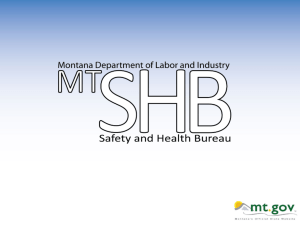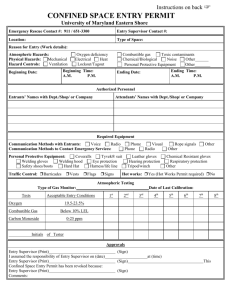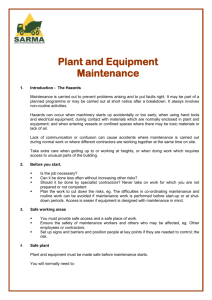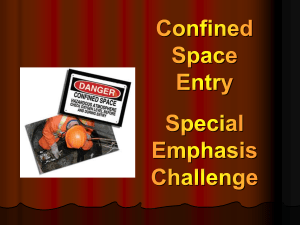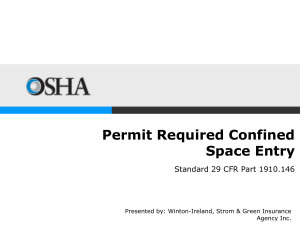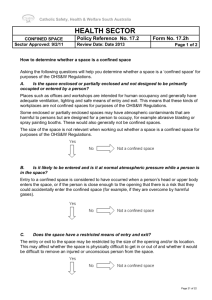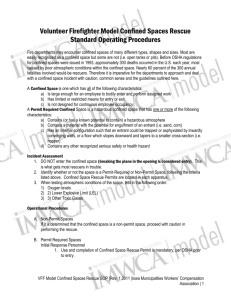Use of State Vehicles - Western Oregon University
advertisement
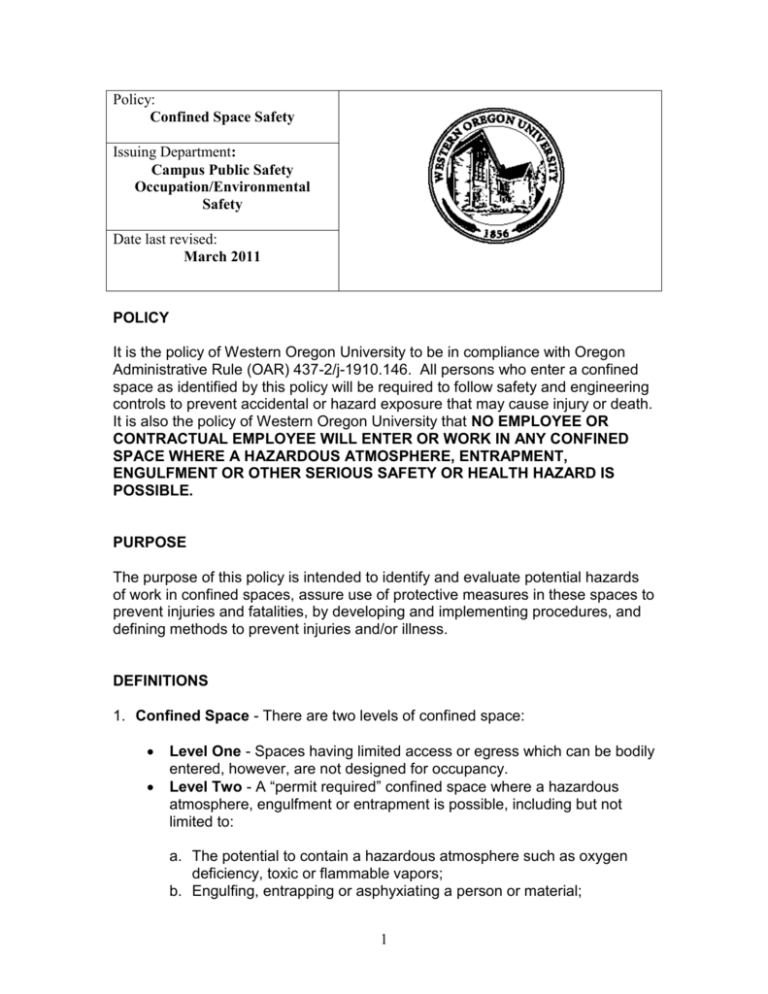
Policy: Confined Space Safety Issuing Department: Campus Public Safety Occupation/Environmental Safety Date last revised: March 2011 POLICY It is the policy of Western Oregon University to be in compliance with Oregon Administrative Rule (OAR) 437-2/j-1910.146. All persons who enter a confined space as identified by this policy will be required to follow safety and engineering controls to prevent accidental or hazard exposure that may cause injury or death. It is also the policy of Western Oregon University that NO EMPLOYEE OR CONTRACTUAL EMPLOYEE WILL ENTER OR WORK IN ANY CONFINED SPACE WHERE A HAZARDOUS ATMOSPHERE, ENTRAPMENT, ENGULFMENT OR OTHER SERIOUS SAFETY OR HEALTH HAZARD IS POSSIBLE. PURPOSE The purpose of this policy is intended to identify and evaluate potential hazards of work in confined spaces, assure use of protective measures in these spaces to prevent injuries and fatalities, by developing and implementing procedures, and defining methods to prevent injuries and/or illness. DEFINITIONS 1. Confined Space - There are two levels of confined space: Level One - Spaces having limited access or egress which can be bodily entered, however, are not designed for occupancy. Level Two - A “permit required” confined space where a hazardous atmosphere, engulfment or entrapment is possible, including but not limited to: a. The potential to contain a hazardous atmosphere such as oxygen deficiency, toxic or flammable vapors; b. Engulfing, entrapping or asphyxiating a person or material; 1 c. Potential to cause serious injury or death (heat stress, moving equipment, electricity); d. Has an internal configuration such that an entrant could be trapped or asphyxiated by inwardly converging walls or by a floor which slopes downward and tapers to a smaller cross-section; e. Contains any other recognized serious health or safety hazard; f. All “permit required” confined spaces will be identified by a painted stencil mark or label stating, “Confined Space - Permit Required”. 2. Permit - A document that is to be posted at the entrance of a confined space prior to entry which includes the following: General Information; Permit Space Hazards; Entry Preparation; Emergency Service; Equipment Required for Entry and Work; Communication Procedures; Authorized Attendants; Testing Record; Authorization by Entry Supervisors; 3. Attendant - A trained person who monitors the entrance, hazards, personnel, emergency service, communications and equipment at a confined space. 4. Entrant - A trained person who passes through an opening into a permitrequired confined space to ensure work activities. The entrant is considered to have entered as soon as any part of the entrant’s face breaks the plane of an opening into a space. 5. Hazardous Atmosphere - An atmosphere which exposes persons to a risk of injury, acute illness, impairment of ability to escape unaided from a permitted space, incapacitation or death, from one or more of the following common causes: Flammable - Gas, vapor or mist in excess of 10% of its lower flammable limit (LFL); Airborne Dusts - Airborne combustible dust at a concentration that meets or exceeds the LFL (this concentration may be approximated as a condition in which the dust obscures vision at a distance of 5 feet); Oxygen Levels - Atmospheric oxygen concentration below 19.5% or above 23.5%; Atmospheric Conditions - Any atmospheric condition that is immediately dangerous to life or health (MSDS can provide assistance). 6. Physical Hazards - Physical hazards in confined space may include moving parts, valves and pipes, noise, heat, live wires, engulfment and falling. 2 7. “Permit Required” Identified Confined Spaces - The following locations are identified as permit entry confined spaces at Western Oregon University: Sawdust bin collector located on the north side of the Physical Plant; Inner firing chamber of all four boilers in the Physical Plant; Condensate return tank located in the Physical Plant Boiler Room; Steam vent vault located on the east side of the University Center; Irrigation vault located to the southeast corner of Valsetz Dining Hall; Three irrigation control vaults on the east side of the football field when any type of activity is being conducted other than mechanical adjustments to the control systems; All electrical vaults located in parking lots or city streets within the campus geographic perimeter; All storm vaults located in parking lots or city streets within the campus geographic perimeter; Any confined space as described in the permit entry confined space definition that has not been identified in this section. PROCEDURES 1. Permit - “Permit required” spaces will not be entered until all hazards are eliminated. A permit (attached) is required to be completed for all “Permit Required Confined Space Entry Work.” Issued permits are to include all work to be done in the space during a shift and encompass all participants, including the following: * * * * * * * * * * General Information; Permit Space Hazards; Entry Preparation; Emergency Service; Equipment required for entry and work; Communication procedures; Authorized person that may enter the confined space; Authorized attendants; Testing record; Authorization by entry supervisors. 2. Monitoring - Is to occur in all portions, top to bottom, corners, spaces, pipes and duct work of the space before and during entry. Results are to be recorded on the permit for each entry. * * Elements Monitored - The confined space is to be monitored at all times for oxygen, lower explosive limit (LEL), and carbon monoxide. Monitor Calibration - The monitor is to be calibrated prior to each day’s use to the manufacturer’s standard of operation for carbon monoxide, hydrogen sulfide and oxygen. 3 * * Alarms - Monitor alarms are to be set at 20.4% (lower limit) and 21.4% (high limit) for oxygen, 10% of LEL for methane, 13 PPM (onehalf of the ACGIH time-weighted average exposure limit) for carbon monoxide. Maintenance on the monitor is to occur based on manufacturer’s recommendation. Monthly testing will be completed and documented by Physical Plant designee and prior to any use. 3. Training - The Physical Plant Facilities Maintenance Supervisor will provide confined space training to all employees assigned to work as entry or standby personnel. Annual training by the Physical Plant Facilities Supervisor will consist of the following: * * * * * * * * * * Hazard Communication; Confined Space Entry Equipment - Including lifeline, monitoring instruments and methods, hoisting equipment, non-sparking tools, ventilation equipment and communication methods; Emergency Rescue - In the event of a confined space incident, the attendant / standby person will notify, via radio, Western Oregon University Campus Public Safety requesting 9-1-1 be summoned. The attendant will utilize the safety line and wench the entrant to safety. Polk County Fire District #1 will assume command upon arrival and may utilize neighboring jurisdictions to mitigate the incident. Protective Equipment - Consists of eye, skin, and respiratory equipment and their maintenance; Confined Space Entry - Review of entry to include ventilation, isolation, communication, posting, barricading procedures and protection from external hazards; Permits - Procedural and permit elements; Hazardous Atmosphere - Instructions including development, prevention, control and working in hazardous atmospheres; Hazard Recognition - Identification of the types of hazards which can be encountered, signs/symptoms of exposure, first aid procedures; Fall protection; LockOut/TagOut - Energy control procedures. 4. Confined Space Work Procedures * * * Confined Space Entry Permit - The Physical Plant Facilities Supervisor or his designee is the person responsible to authorize entries and have oversight of the monitoring section of the permit. Unauthorized Entry - Work will not be performed in unauthorized confined spaces by Western employees or contractors. Hazardous Free Spaces - Spaces are to be cleaned and purged prior to entry to include being free of hazardous atmospheres. Oxygen content of 20.4-21.4%, toxic content less than 1/2 of the exposure limits and flammability levels at less than 10% of LEL for specific gas/vapor for the entire entry period. 4 * * * * * * * * * 5. LockOut/TagOut - Energy control procedures for all energy sources are to be followed. Monitored Spaces - Spaces are to be monitored before entry and continuously through the work process. Entry persons are to be evacuated whenever a monitor alarm sounds, and reassessment of the space performed. Ventilation will occur throughout the work if initial monitor results indicate the atmosphere is not acceptable. Non-Sparking Tools - Only non-sparking tools may be used whenever flammable or combustible atmospheres are capable of being created. Work Review is to occur prior to entry to determine if the work itself will contribute to an unacceptable atmosphere, including welding and gluing. Hot Work Permit - If equipment that generates a hazardous atmosphere by consuming oxygen or creating a harmful vapor or gas is used in a confined space, additional precautions are to take place to eliminate the hazard and protect the entrant person. A second permit is required detailing additional precautions required. Attendant / Standby Person will be at the point of entry in constant communication with the entry person(s). The standby person can order an evacuation when a hazard or ill effect of an entrant is noted. The standby person must call 9-1-1 and summon rescue. Rescue – Polk Fire District #1 will set up the Incident Command center. Neighboring jurisdictions, Salem Fire and Rescue and or Dallas Fire and Rescue will do the actual entry to rescue the entrant if required. If the entrant has a lifeline, the standby person is to call Public Safety for initial response until Fire and Rescue arrives. If the person can be retrieved through a pre-existing lifeline the standby person and Public Safety may attempt to retrieve the person if it can be determined that no further serious harm will occur. Heat Stress and Disorders - Heat stress may cause a person to process information poorly, disregard danger warnings, make poor choices, have slower reaction time, have impaired coordination, or misjudge distances. Persons who begin to experience heat cramps, heat exhaustion or heat stroke are to remove themselves from the space. Permit Entry Procedures - Persons who determine a need to enter a “permit required” confined space are to comply with the following procedures: * * Inform supervisor Determine Hazards - Determine the potential hazards in the confined space (e.g., oxygen deficiency, internal configurations, or depths impairing the ability to escape unaided should an injury or acute illness occur). 5 * * * * * Test Atmosphere - Test upper and lower levels using the gas monitor which may include using plastic tubing on the lower levels. Ventilation is to occur if a hazard is identified or possible. Personal Protective Equipment - Wear protective equipment based on potential hazardous atmosphere which may include, but not be limited to, gloves, respirator, boots, etc. (This will include a lifeline, shoulder harness, and retrieval system.) Complete Permit - Complete the entire permit and have it signed by the Physical Plant Facilities Maintenance Supervisor. Attendant / Standby Person - Is to be located at the entry point in constant communication. Rescue Notification - Polk Fire District #1 is to be notified prior to entering a confined space. 6. Contractors - When contracted work is to occur in a “permit required” confined space the Physical Plant Facilities Supervisor is to be notified. He will provide the contractor with Western’s Confined Space Program, MSDS and hazard information. It will be the responsibility of the contractor to evaluate, monitor, and enter the space at their own assumption of risk. 7. Shared Work - In the event a contractor and Western work together in a confined space, Western’s confined space procedures will be followed. AUTHORITY Oregon Administrative Rule (OAR) 437-2/J-1910,146. RESPONSIBILITY Before entering a confined space, authorization must be received from the Physical Plant Facilities Supervisor or designee who will also have oversight of the work to be done. In the event of a confined space incident, the attendant / standby person will notify, via radio, Western Oregon University Campus Public Safety requesting 9-1-1 be called. 9-1-1 will notify Polk County Fire District #1 and if needed, neighboring jurisdictions to mitigate the incident. Date of next review: March 2012 Alternate formats of this policy are available from the Office of Human Resources. 6 CONFINED SPACE Training Ledger Instructor: ____________________________Date of Training:____________ As an employee of Western Oregon University, I understand that I may be requested to enter a permit- required confined space as part of my job duties. In compliance with OAR 1910.146, I understand the following information has been covered in training provided by my supervisor. I also acknowledge that if I do not understand part or all of the points covered, it is my responsibility to seek clarity from my supervisor. Definition of a confined space vs. a permit entry confined space; Definition of Attendants and Entrants; What constitutes a hazardous atmosphere; Procedures for entering a confined space; What personal protective equipment is to be used in a confined space; How to meet the requirements and complete a confined space entry permit; Procedures to calibrate and use an oxygen and gas monitor; When and how the rescue team is used in retrieving a confined space worker; When and how a hot work permit is used. Printed Name Signature ___ _________ ____ ____ ____ ____ ____ ____ ____ ____ 7 WESTERN OREGON UNIVERSITY Physical Plant Services Confined Space Entry ENTRY PERMIT Location: Date: Time Permit Issued: Permit Authorized by (Supervisor): Time Permit Expires: Describe Job: Describe Potential Hazards: Authorized Entrants: Have the following precautions been taken? Circle one that applies to task 1. Are the entry, standby, and rescue personnel properly trained in CSE procedures, emergency action, required PPE selection, use, limitations, maintenance; and Hazard Communication? Yes No N/A 2. Have confined space interconnections, electrical switches been completely isolated, locked out, tagged and tested? Yes No N/A 3. Does the entry person have the only key to the lock? Yes No N/A 4. Has proper rescue equipment been fitted to the entrant? Yes No N/A 5. Have all sections of the space been monitored, ventilated, and re-monitored for: Yes No N/A MONITOR READINGS: Co? less than 25 ppm) H25? “ Hydrogen Sulfide” (less than 10 ppm) Oxygen? (19.5 to 23.5 %) LEL/Ch4? (less than 10% required) Pre. ___ ___ ___ ___ Mid ___ ___ ___ ___ Exit ___ ___ ___ ___ 6. Have current MSDS(s) of products been reviewed by those involved? Yes No N/A 7. Has space been set up for ventilation for full work period? Yes No N/A 8. Has proper PPE been specified for use, checked for fit? Yes No N/A 8 9. Have entry persons been equipped with oxygen/LEL/CO monitors and emergency escape respirators? Yes No N/A 10. Have proper tools been specified and workers equipped? Yes No N/A 11. Has proper lighting equipment been provided? Yes No N/A 12. Has standby personnel been provided? Yes No N/A 13. Appropriate signs & barricades in place and personnel notified? Yes No N/A 14. Is hot work to be done? Yes No N/A 15. Have special procedures been satisfied? (Local ventilation, monitoring combustibles/flammables removed). Yes No N/A 16. Precautions taken to prevent creation of hazardous Yes atmosphere while entry personnel are in the confined space (such as local ventilation, monitoring, escape provisions)? No N/A 17. Supervisor has reviewed all procedures particular to this specific task? Yes No N/A 18. Are rescue and standby personnel on site, and in communication? Yes No N/A Approved by: _________________ Signature ___________________________________________ Printed Name and Title 9 ________________ Date
